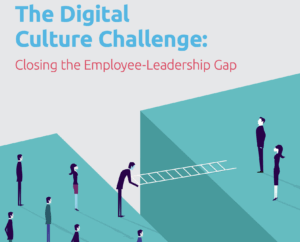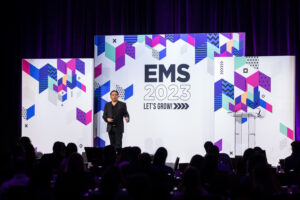
Businessmen in office
Guest post by Omar Akhtar (@obakhtar), Managing Editor, Altimeter Group, a Prophet company
Imagine you’re getting ready to drive your car. But when you turn on the engine, you get a mobile notification telling you that your oil needs to be changed, and it gives you a link to the nearest dealership with a 10% discount coupon. You’re left surprised and delighted by the sheer, almost magical convenience of it all. But is that event classified as a sales, service or marketing interaction? The correct answer is: all of the above.
Marketing is often regarded as the de facto custodian of the customer experience, especially when it comes to digital engagement. Hence it makes sense for it to have the best, most advanced tools for providing the delivering the optimal experience. But in today’s world of always connected, always on experiences, customer experience management is no longer just the responsibility of marketing, or even sales or service. Today, the entire company is responsible for the customer experience. And hence, the technology for customer experience management must allow multiple teams within a company to operate it in a unified, way delivering a seamless customer experience across all touchpoints.
For companies that have been moving towards the idea of unified “marketing cloud” or an integrated system of tools to operate all marketing channels, we’re saying, think bigger. To truly recognize the customer across each touchpoint, and provide a seamless experience at every interaction, the technology strategy must evolve from “marketing cloud” to the “customer experience cloud.”
Of course, that’s no easy task. Raise your hand if you’re tired of being told to “break down silos” but you don’t know where to start. Raise your hand if you want to build a great customer experience but you can’t define what that is. And raise your hand if you’re in charge of buying marketing technology but are overwhelmed by the thousands of software options that are available to you.
A new report from Altimeter, authored by myself and Charlene Li, titled: “The Customer Experience Cloud: How To Unify The Organization Around A Seamless Customer Experience” is written for anyone who identifies their organization as having these problems. The new reality of commerce is that brands are expected to be present on an ever-increasing number of channels, both online and offline . And customers expect to be recognized as the same unique individual across all of these channels. They want personalized content, real-time engagement, recognition across devices and serendipitous discovery all at once. This requires a major upheaval not just in the technology being used, but the organization of the company as well.
In this report, we’ve provided the essential technological and organizational components that companies need to unify the efforts of sales, service and marketing around building a seamless, cross-channel customer experience. Based on research interviews with leading brands such as Nike, McDonalds, General Motors and General Electric, we’ve found the common best practices for companies working towards this goal. And finally, we’ve created a starting guide for companies on choosing the right technology to support their unified customer experience plan, with an overview of the leading technology vendors that can help deliver on this vision.
Putting the customer experience cloud into practice is a major effort that will mean reorganizing teams, setting new governance, buying new technology and establishing new processes. It is nothing short of a comprehensive digital transformation. With so many parts of the puzzle required to fall in place simultaneously before any real execution, the most daunting part is knowing where to start. And with this report, we believe we can give companies that crucial starting point for how to adapt, and thrive in the face of what we think will be a major disruption in the way customers interact with brands in the digital age.
Omar Akhtar is the Managing Editor for the research team at Altimeter, A Prophet Company where he oversees the editorial process behind all of Altimeter’s publications, including its research reports, daily blog and multimedia content. In addition, he conducts and publishes research in the area of marketing/ customer experience technology





Imagine I’m late for work. I have an important meeting. And suddenly I get nagware telling me I have to visit a dealershipo, pay money all for something which gives me no instant benefit. This may be service, sales and marketing in harmony, but it is far from customer friendly.
Customer Service is not about making them come to you. Nor about single paid transactions.
The connected ECU should be telling you permanently about the car’s condition. Things like oil change shouldn’t be a sudden event. The customer should be given several options – we’ll come to you at home, visit you and do it while your car is parked in the car park at work, or you can come to us if you’d prefer (we’re situated in your favourite mall) and we’ll do it while you shop/eat/whatever. We send you a voucher for a restaurant you said you liked when you bought from us. If the answer is home or office, we give you a choice of date and time, either do it on the spot or arrive in a courtesy vehicle, leave the keys with you and take your car away for a short, pre-booked appointment – back within a couple of hours and you probably don’t even notice it is gone. For longer stuff, of course you have the courtesy car for the day or even the weekend. And all of this transaction comes free, part of the after-sales package you took on with the car.
That’s customer service. But it requires a joined up company to work. One which doesn’t simply think of booking everyone in at 9 and out at 5. One which uses the rental fleet imaginatively. Which thinks 24/7, not Monday to Friday. And which is connected with the local community (restaurants, shops etc.) not a standalone. Certainly not one where sales, marketing and service can’t even work together.
It’s not only smart, but it’s a necessity to have a large emphasis on the customer experience. That direct connection with the customer is, more often than not, what could make or break the chances of gaining repeat business.